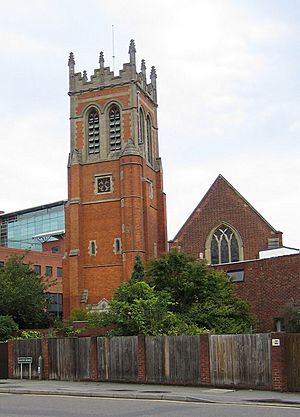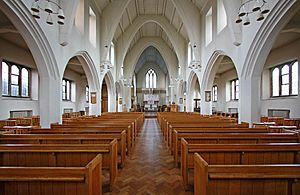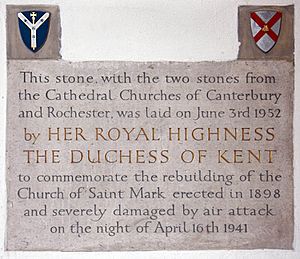St Mark's Church, Bromley facts for kids
Quick facts for kids St Mark's Church, Bromley |
|
|---|---|
 |
|
| 51°23′54″N 0°00′57″E / 51.39837°N 0.01586°E | |
| Country | England |
| Denomination | Church of England |
| Website | www.stmarksbromley.co.uk |
| Architecture | |
| Architect(s) | Evelyn Hellicar |
| Years built | 1895-1898 |
| Administration | |
| Parish | St Mark's Bromley |
| Deanery | Bromley |
| Archdeaconry | Bromley and Bexley |
| Diocese | Rochester |
St Mark's Church in Bromley is a special church that belongs to the Church of England. You can find it on Westmoreland Road, just south of the town center.
Contents
The Church's Story
How St Mark's Began
Back in the 1880s, people in the Bromley South area already gathered for church services. They had been talking for years about building a proper church nearby.
In 1884, the vicar of St Peter and St Paul, Bromley, Reverend A. G. Hellicar, received a gift. A local man named Samuel Cawston gave them an iron church building. It came with all its furniture and fittings. This iron church used to be in Addison Road, Bromley Common. It was moved and set up again in what is now St Mark's Road, Masons Hill. Eley Soames kindly let them use the land. This temporary church was used until 1898.
In 1891, a local newspaper called the Bromley Record wrote about it. They said, 'It's possible that a fund will start to replace the iron building. The St Mark's churchgoers have been using it for the past five years.'
In 1897, the big decision was made. The land at the bottom of Westmorland Road was bought for £500. Thomas Dewey and Eley Soames bought it. In 1896, a meeting happened at South Hill Wood. This was Mr. Dewey's house on Westmorland Road. At this meeting, everyone approved the plans for the new church. The architect was Evelyn Hellicar, who was the son of the Vicar of Bromley.
On Saturday, October 22, 1898, the new church was officially opened. Dr. William Walsh, the Bishop of Dover, led the ceremony. Canon Murray and Sir John Hassard were also there. On the Sunday evening after the opening, the church was so full that many people could not get inside.
Only the bottom part of the church tower was built at first. This part held the main entrance. The tower was made taller in 1903. It was officially opened on January 10, 1904. The tower was built with red bricks from Dunton Green. It was decorated with special stone from Doulting in Somerset.
Damage During World War II
On Wednesday, April 16, 1941, Bromley faced a very strong air raid. This attack started in the evening and lasted until the early morning. A local report from that time said:
Many public buildings and shops, as well as private houses, were badly damaged or destroyed. This included both the main church, St Peter and St Paul’s, and St Mark’s. St Mark's Church was hit by both fire bombs and powerful explosive bombs. There was a serious fire in the church's southwest corner and garden. The fire was also just inside the main entrance. The entire roof of the main part of the church and its side sections was gone. The upper balcony had fallen down. The baptismal font was still there but badly broken. The War Memorial Board was broken and moved. All the window glass was destroyed. Much of the stone around the windows was broken. The pulpit and wooden seats were broken or covered in fallen wood. The stone and brickwork of the front and back windows were broken. They were smashed and pushed outwards onto the grass. In the front part of the church, much of the carved screen and the Holy Table were still there, only slightly damaged. The organ was completely destroyed.
Some parts that were saved were taken to St Mark's Church Hall. The carved screen behind the altar was protected with covers. Only the church tower was left unharmed.
Rebuilding the Church
Even after the bombing, a special service was held every year in the damaged church. This showed that people planned to rebuild it.
The new church was designed by T. W. G. Grant. It was built by David Nye and Partners. The builders used the original foundations, so the new church kept the same size and shape. The old arches in the main part of the church were used in the new building. The lower part of the arch leading to the altar area was also saved. The old carved decorations and the choir seats were also kept.
On June 3, 1952, HRH The Duchess of Kent placed the corner stone for the rebuilding. In 1953, St Mark's was officially opened again. The Bishop of Rochester, Dr. Christopher Chavasse, led the ceremony. The Vicar, Reverend H. J. A. Edwards, was also present.
St Mark's Church Today
The church you see today includes the original tower. It also has many bricks and pieces from the old Victorian building. Inside, you can see a mix of styles. The curved arches designed by Grant look different from the older, straight-lined shapes by Hellicar.
The carved screen behind the altar and the choir seats are still there from before the war. The first baptismal font was accidentally broken during the war. The one you see now was put in during the 1950s. The pipe organ, designed by Rushworth and Dreaper, and the lectern (where readings are given) are also from the 1950s.



